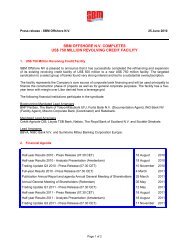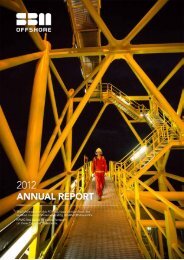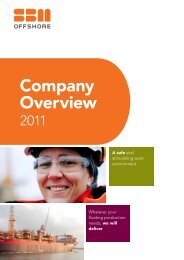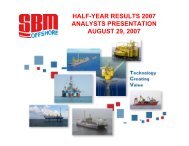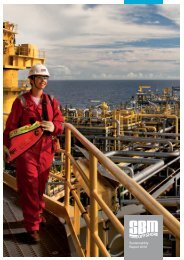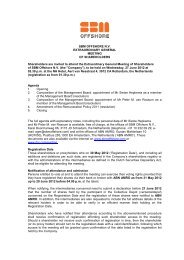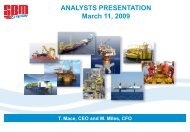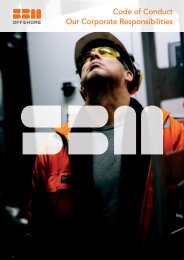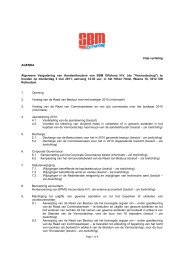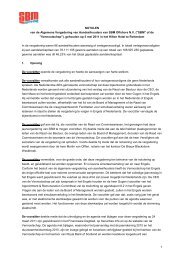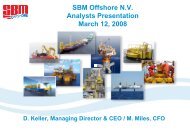Annual Report 2010 - SBM Offshore
Annual Report 2010 - SBM Offshore
Annual Report 2010 - SBM Offshore
You also want an ePaper? Increase the reach of your titles
YUMPU automatically turns print PDFs into web optimized ePapers that Google loves.
Financial Review / Financial Statements <strong>2010</strong><br />
realisable value. Cost is determined using the first-in<br />
first-out method. Net realisable value is the estimated<br />
selling price in the ordinary course of business, less the<br />
estimated costs of completion and selling expenses.<br />
Inventories comprise semi-finished products, finished<br />
products and spare parts. Semi-finished and finished<br />
products are valued at cost including attributable overhead.<br />
Spare parts are stated at the lower of purchase<br />
price and market value.<br />
Construction work in progress<br />
Construction work in progress is stated at cost plus<br />
profit recognised to date less a provision for foreseeable<br />
losses and less invoiced instalments. Cost includes<br />
all expenditures related directly to specific projects and<br />
attributable overhead. Where instalments exceed the<br />
value of the related costs, the excess is included in current<br />
liabilities. Advances received from customers are<br />
included in current liabilities.<br />
Trade and other receivables<br />
Trade receivables are amounts due from customers for<br />
sales performed in the ordinary course of business. If<br />
collection is expected in one year or less (or in the normal<br />
operating cycle of the business if longer), they are<br />
classified as current assets. If not, they are presented<br />
as non current assets.<br />
Trade and other receivables are recognised initially at<br />
fair value and subsequently measured at amortised<br />
cost using the effective interest method, less allowance<br />
for impairment. An allowance for impairment of<br />
trade and other receivables is established when there is<br />
objective evidence that the Company will not be able to<br />
collect all amounts due under the original terms of the<br />
receivables.<br />
Significant financial difficulties of the debtor, probability<br />
that the debtor will enter bankruptcy or financial<br />
reorganisation, and default or delinquency in payments<br />
are considered indicators that the trade and other<br />
receivables are impaired. The amount of the allowance<br />
is the difference between the asset’s carrying amount<br />
and the present value of estimated future cash flows.<br />
The carrying amount of the asset is reduced through<br />
the use of an allowance account and the amount of the<br />
122 <strong>SBM</strong> <strong>Offshore</strong> – <strong>Annual</strong> <strong>Report</strong> <strong>2010</strong><br />
loss is recognised in the income statement. When a<br />
trade or other receivable is uncollectible, it is written off<br />
against the allowance account. Subsequent recoveries<br />
of amounts previously written off are credited in the<br />
income statement.<br />
Derivative financial instruments and<br />
hedging activities<br />
The Company uses derivative financial instruments<br />
such as forward currency contracts and interest rate<br />
swaps to hedge its risks associated with foreign currency<br />
and interest rate fluctuations. Such financial<br />
instruments are initially recognised at fair value on<br />
the date on which a financial contract is entered into<br />
and are subsequently remeasured at their fair value.<br />
The method of recognising the resulting gain or loss<br />
depends on whether the derivative is designated as a<br />
hedging instrument, and if so, the nature of the item<br />
being hedged. Derivative financial instruments are presented<br />
as assets when the fair value is positive and as<br />
liabilities when the fair value is negative.<br />
Any gains or losses arising from changes in fair value<br />
on financial instruments that do not qualify for hedge<br />
accounting are taken directly to the income statement.<br />
The fair value of forward currency contracts is calculated<br />
by reference to current forward exchange rates<br />
for contracts with similar maturity profiles using quoted<br />
market rates. The fair value of interest rate swap contracts<br />
is determined by reference to market rates for<br />
similar contracts.<br />
For hedge accounting, hedges are classified as:<br />
• fair value hedges when hedging exposure to<br />
changes in fair value of a recognised asset or liability<br />
or a firm commitment (fair value hedge);<br />
• cash flow hedges when hedging the exposure to<br />
variability in cash flows that is either attributable to a<br />
particular risk associated with a recognised asset or<br />
liability or a highly probable forecasted transaction<br />
(cash flow hedge);<br />
• hedges of net investments in a foreign operation (net<br />
investment hedge).<br />
At the inception of the transaction, the Company<br />
formally designates and documents the hedge relationship<br />
to which the Company wishes to apply hedge



